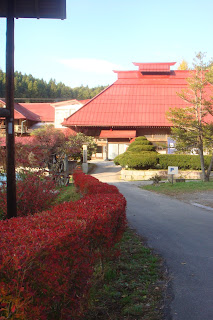Hi,
Spent last Thursday, the holiday, celebrating the harvest in Hirata-mura, about 30 miles south east of Koriyama. In the past we've planted and harvested the rice but sadly Sato-san died of illness last year and the work has been contracted out. But with a yield of 750 kilos there was still a lot of work to be done taking the brown rice to the mill to be polished, bagging it up and sending it off to the many supporters who're prepared to eat rice from Fukushima. Having said that the rice in the area has been tested and shows no trace of caesium and a letter with these results was put in every package. (I have to say though that I opted to take white rice this year - cleaner than brown rice - just to be on the safe side.)
It was a lovely day to spend in the country, the weather mild, trees beginning to turn colour, some post-harvest activity in the fields (threshing, cutting grass, burning stubble), but generally still and calm. Paddy fields, dry fields, villages, bamboo groves, woods: there's a word in Japanese for this country scene, satoyama (里山) which has been coined by conservationists to describe the symbiosis of people in their environment and biodiversity.
The Satoyama are under threat. No one looks after the woods any more. The average age of the farming population is 66 and the vast majority of farmers have another job - they can't earn a living from farming alone. That's in spite of subsidies for growing rice, for not growing rice and with the price of rice ten times the world price. I don't begin to understand the complexities of farming here but the country is currently split in two over whether to enter talks with a view to joining the TPP, the Trans Pacific Partnership, a sort of EU with free movement of goods and no tariffs. America and Australia are in. As are Chile, Peru and Malaysia. China's not in and Japan is dragging its feet. Of course the farmers are against.
But the rice really was delicious. How much water do you add to rice when you cook it? I was amazed to hear that for each cup of this rice you need less than a cup of water. First, it's fresh and still moist (it'll need more as the season progresses), secondly it hasn't been in a dryer like most rice but dried out in the fields. So it had a beautiful nutty aroma, glistened in the bowl, and was chewy to eat. Delicious.
Last night I went to a one man show by Issey Ogata. I saw him in London over ten years ago. If you get the chance do go and see him. He's immensely talented and very funny. He did seven sketches, changing on stage, becoming seven different personalities: the old lady who can't ride a bike, a foundry worker whose most exciting moment in fifty years work had been the time a goat got into the factory, or the lady of a certain age in a bar. Just everyday scenes but very cleverly observed and acted out with a face that moves like elastic.
Back to work tomorrow.
Anne
 |
| Sato-san's family home |
 |
| Harvest festival |
 |
| Rice hanging out to dry the old fashioned way |
 |
| Me measuring rice into 5 kg bags |
 |
| 30kg sacks of Fukushima rice stacked up in the old farmhouse |
 |
| The rice really is good, fragrant and glistening |
 |
| Country scene |








Hello Anne,
ReplyDeleteI am a producer with the BBC World Service in London. Could you possibly email me as we would be very interested in speaking with you.
Many thanks
Rob (robert.brown2@bbc.co.uk)